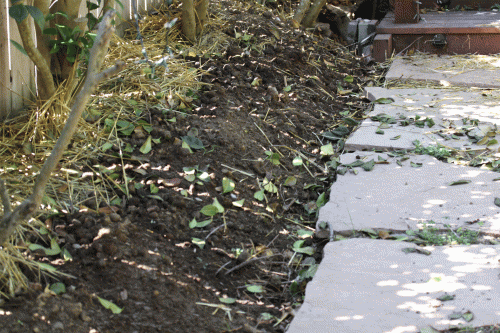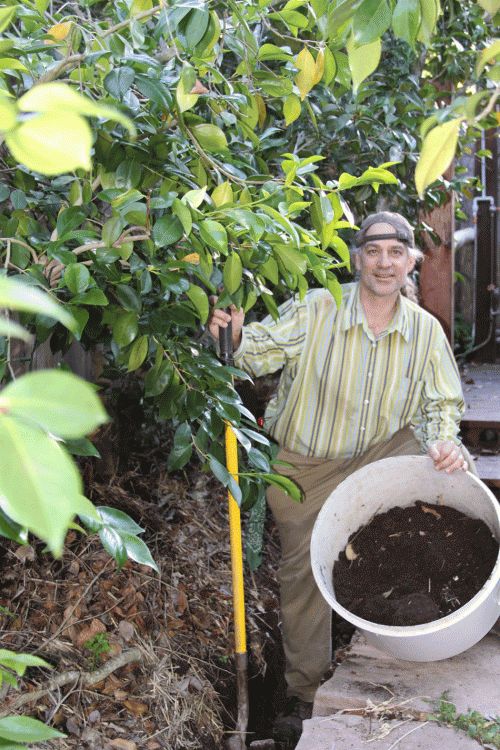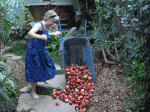
Day 5 in this 6-day video series: Preparing patio pots for winter veggie planting.
First a video re “Patio Veggie Pots”, then some animal habitat pics (below the video):
Patio Veggie Pots 5 of 6 (video):
Soil Making in Leaf Trench Highway (pics):

Mushrooms pop out of Leaf Trench Highway’s manure after the first rain. Good stuff! Having the fungi/mushrooms means the manure will break down faster.
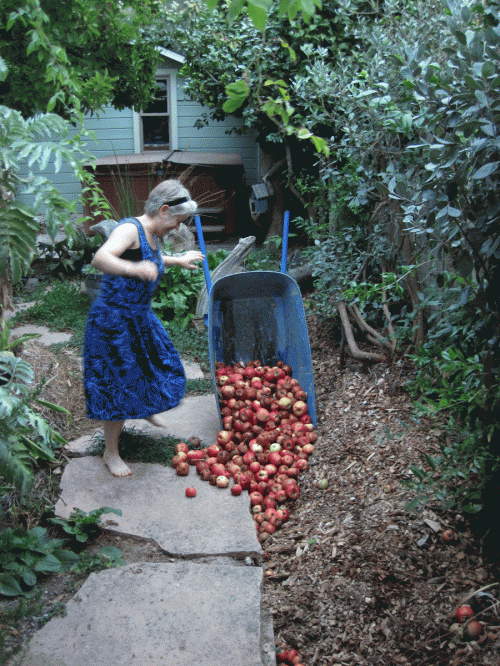
Anita dumps a new load of soil critter food. These apples were “debris” for a neighbor that wanted under her tree “cleaned up”. The soil critters and we are sure happy to have the mess!
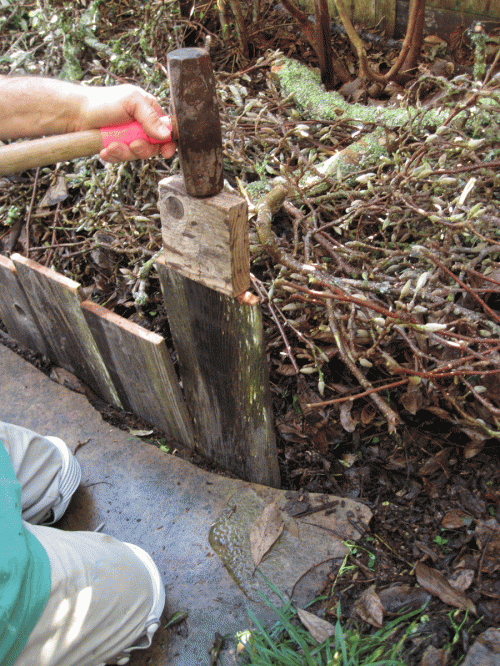
A short retaining wall is added to Leaf Trench Highway. The short wall of re-used fence boards will allow a higher pile of organics to be heaped into Leaf Trench Highway, yet keep the walkway clear. Note how the block keeps the sledge from splitting the dry fence board.
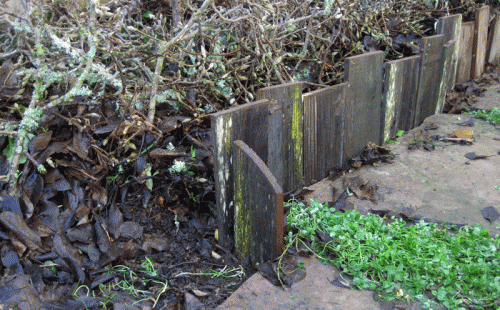
Leaf Trench Highway’s short retaining wall in place, holding back tulip magnolia prunings (limbs and twigs). Lichens, mosses, and algae so abundant! Does life get any better?!
Pics and captions from Tony’s new book, Habitat It and They will Come :
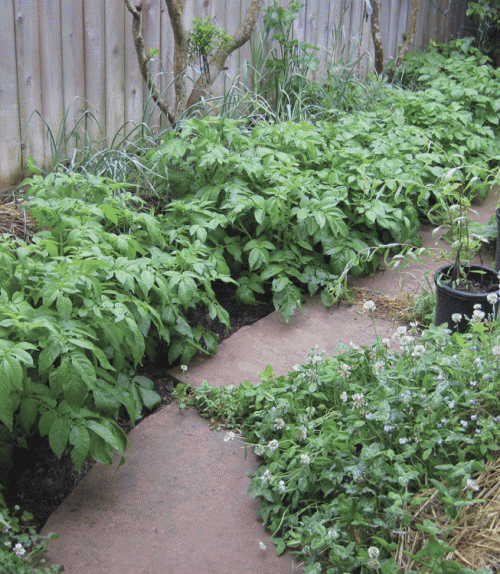 Figure 2.11 White Clover and Leaf Trench Highway. Leaf Trench Highway is about making soil — the 3 foot deep trench is filled with green mulch (for example, a whole lot of pumpkin vine prunings), then covered over with old (cool) manure and compost. Potato starts are dug in. Harvest, 6-9 months later, yields full-grown potatoes PLUS a long, deep trench of beautiful soil to use elsewhere in the garden. The white clover attracts pollinating insects to the potato flowers, adds nitrogen to green mulching, and is a sheltering go-between for critters to travel from one garden bed to another. Laying the slate pavers on soil, and not on sand or cement, allows soil fungi, microbes, and larger animals to pass through the soil, thereby assisting the growth of the clover cover crop.
Figure 2.11 White Clover and Leaf Trench Highway. Leaf Trench Highway is about making soil — the 3 foot deep trench is filled with green mulch (for example, a whole lot of pumpkin vine prunings), then covered over with old (cool) manure and compost. Potato starts are dug in. Harvest, 6-9 months later, yields full-grown potatoes PLUS a long, deep trench of beautiful soil to use elsewhere in the garden. The white clover attracts pollinating insects to the potato flowers, adds nitrogen to green mulching, and is a sheltering go-between for critters to travel from one garden bed to another. Laying the slate pavers on soil, and not on sand or cement, allows soil fungi, microbes, and larger animals to pass through the soil, thereby assisting the growth of the clover cover crop.
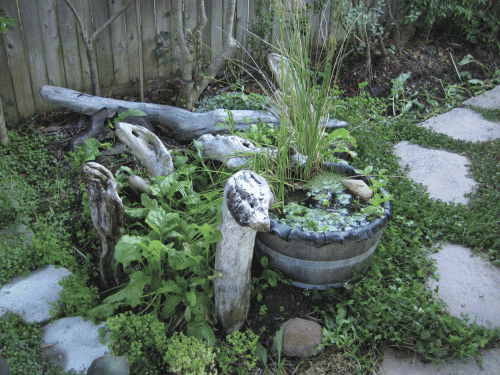 Figure 3.37 The After of Salamander Resort. One year later and the resort is still operating. Driftwood creatures, a thriving beet crop, and Salamander Sunny Swimhole hide the goings-on eight feet below. See Figure 3.36 for “The Before”. Watering the pond waters the beets waters the compost waters the wood chips waters the oak rounds waters tank cavities waters Salamander Shady Shallows, AND waters the adobe clay earth surrounding Salamander Resort. Water + Cavities + Microbes + Mollusks (slugs and snails) + Worms + Insects = Happy Salamanders. The half wine barrel pond, with a 5’ x 5’ sheet of pond liner, was home this spring to Pacific Tree Frogs (and tadpoles). Many types of insect on the wing visit the pond. A salamander must be living somewhere in all that! Note some habitat features: clover on the slate path links this habitat to the rest of the garden, the pond’s surface rocks provide a critter rest stop, the “fedge” (food hedge of fig, pineapple guava, loquat, and pomegranate) along the fence provides flowers and food, and the compost in Leaf Trench Highway at the base of the fedge attracts its own ecosystem of soil makings and critters.
Figure 3.37 The After of Salamander Resort. One year later and the resort is still operating. Driftwood creatures, a thriving beet crop, and Salamander Sunny Swimhole hide the goings-on eight feet below. See Figure 3.36 for “The Before”. Watering the pond waters the beets waters the compost waters the wood chips waters the oak rounds waters tank cavities waters Salamander Shady Shallows, AND waters the adobe clay earth surrounding Salamander Resort. Water + Cavities + Microbes + Mollusks (slugs and snails) + Worms + Insects = Happy Salamanders. The half wine barrel pond, with a 5’ x 5’ sheet of pond liner, was home this spring to Pacific Tree Frogs (and tadpoles). Many types of insect on the wing visit the pond. A salamander must be living somewhere in all that! Note some habitat features: clover on the slate path links this habitat to the rest of the garden, the pond’s surface rocks provide a critter rest stop, the “fedge” (food hedge of fig, pineapple guava, loquat, and pomegranate) along the fence provides flowers and food, and the compost in Leaf Trench Highway at the base of the fedge attracts its own ecosystem of soil makings and critters.
Happy planting veggies on your patio and see you tomorrow.
Tony

